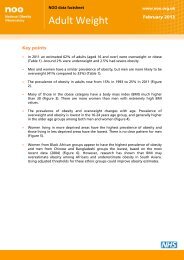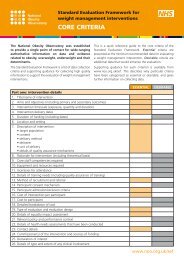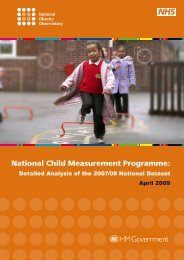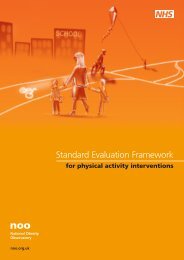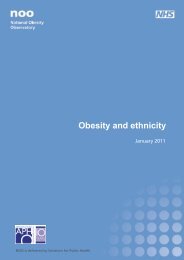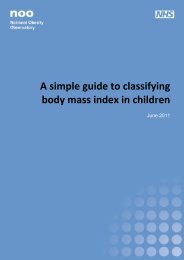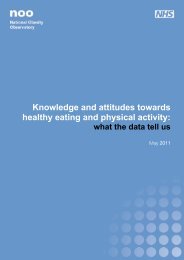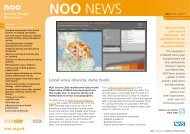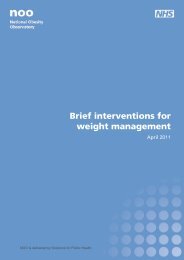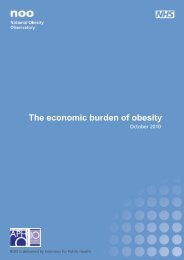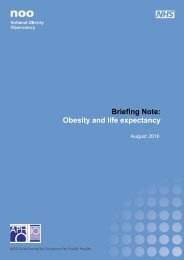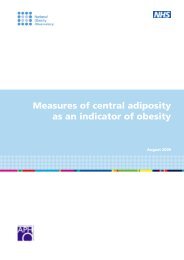Review of dietary assessment methods in public health - National ...
Review of dietary assessment methods in public health - National ...
Review of dietary assessment methods in public health - National ...
You also want an ePaper? Increase the reach of your titles
YUMPU automatically turns print PDFs into web optimized ePapers that Google loves.
Validation and reliabilityThe DQS questionnaire was validated aga<strong>in</strong>st a 198-item FFQ. The results <strong>in</strong>dicated thatthe questionnaire can adequately assess <strong>dietary</strong> quality. A higher DQS (higher <strong>dietary</strong>quality) was significantly associated with lower <strong>in</strong>take <strong>of</strong> total and saturated fat, and ahigher <strong>in</strong>take <strong>of</strong> carbohydrate, fibre, various vitam<strong>in</strong>s and m<strong>in</strong>erals, fish, fruit,vegetables and whole–gra<strong>in</strong> products. Correlation coefficients between the DQS andthe 198-item FFQ varied considerably between <strong>dietary</strong> components. There was also asignificant negative association with waist circumference and the Copenhagen Riskscore (a coronary risk score for myocardial <strong>in</strong>farction) when adjustments for sex and agewere made. When adjustments were made for smok<strong>in</strong>g, physical activity levels andeducation, associations with HDL-cholesterol and waist circumference did not rema<strong>in</strong>.The authors state that the lack <strong>of</strong> association for HDL-cholesterol may be l<strong>in</strong>ked tosmok<strong>in</strong>g and physical activity levels, which may have a stronger impact on HDL levelsthan <strong>dietary</strong> factors. In addition, the DQS showed no association with BMI. Noexplanation is suggested as to why this might be.There is no report <strong>of</strong> the scales used with<strong>in</strong> the DQS questionnaire be<strong>in</strong>g formallymeasured, and it is not clear whether items would correlate directly with each other.For example, three po<strong>in</strong>ts are awarded for daily <strong>in</strong>take <strong>of</strong> more than five portions <strong>of</strong>vegetables, but three po<strong>in</strong>ts are also awarded for no <strong>in</strong>take <strong>of</strong> fats. It is not clear ifthese factors are l<strong>in</strong>ked directly and whether a similar value should be awarded toboth.It is likely that each <strong>dietary</strong> factor will have a different impact on cardiovascular diseaserisk, and scores should be weighted accord<strong>in</strong>gly. However, this may be difficult todeterm<strong>in</strong>e and apply simply. The questionnaire was designed to provide a broadoverview <strong>of</strong> <strong>dietary</strong> quality <strong>in</strong> a large population, and to categorise <strong>in</strong>to groups withoverall <strong>health</strong>y, average, or un<strong>health</strong>y diets. It is not suitable for measur<strong>in</strong>g specificnutrient <strong>in</strong>takes and is not recommended for an <strong>in</strong>-depth <strong>dietary</strong> <strong>assessment</strong>. No<strong>in</strong>formation is provided on the test–retest reliability <strong>of</strong> the questionnaire. There is someevidence that the questionnaire can detect change over time (personal communication)but this <strong>in</strong>formation is yet to be published.UsageThere are only eight items to complete <strong>in</strong> this tool so it is likely that it would berelatively straightforward to complete. However, no <strong>in</strong>dication is given on how longthe questionnaire should take.Analysis should also be straightforward and it is likely that specific s<strong>of</strong>tware would notbe needed. The questionnaire was developed for self-completion by adults aged 30–60years <strong>in</strong> an urban Danish population. It is unclear if such a questionnaire could betranslated for use <strong>in</strong> other populations, and it is likely that it would need to bevalidated and adjusted for use <strong>in</strong> the UK. The questionnaire is available for use, but nospecific guidance is available. The pr<strong>in</strong>cipal author is will<strong>in</strong>g to work with researcherswish<strong>in</strong>g to use the questionnaire.Reference paperT<strong>of</strong>t U, Krist<strong>of</strong>fersen LH, Lau C, et al. The Dietary Quality Score: validation and associationwith cardiovascular risk factors: the Inter99 study. European Journal <strong>of</strong> Cl<strong>in</strong>ical Nutrition.2007; 61(2): 270–8.NOO | <strong>Review</strong> <strong>of</strong> <strong>dietary</strong> <strong>assessment</strong> <strong>methods</strong> <strong>in</strong> <strong>public</strong> <strong>health</strong> 27



